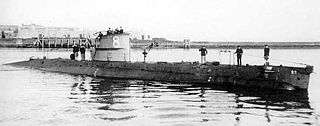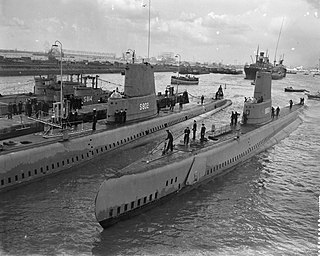The Military ranks of the Netherlands armed forces are the military insignia used by the armed forces of the Netherlands.
The Netherlands Naval Aviation Service is the naval aviation branch of the Royal Netherlands Navy.

HMS H6 was a British H-class submarine of the Royal Navy built by Canadian Vickers & Co. during World War I.
The Royal Netherlands Navy Mine Service is a department within the Royal Netherlands Navy that is responsible for keeping Dutch coastal waterways and approaches to major seaport areas mine-free. It was established out of the Royal Netherlands Navy Torpedo Service in 1907.
The O 9-class submarine consisted of three submarines, built for the Royal Netherlands Navy. Used for patrols in the Dutch home waters. The class comprised O 9, O 10, and O 11. Its diving depth was 60 metres (200 ft).

The Samarang class was a class of steam screw gunvessels of the Royal Netherlands Navy. The class originally comprised Samarang, Batavia and Makassar, but was later extended.

Onrust Dock of 5,000 tons, was a floating dry dock which served in the Dutch East Indies from 1881 till 1924.

The Buyskes class was a class of two hydrographic survey vessels that were part of the Dutch Hydrographic Service of the Royal Netherlands Navy. Together with HNLMS Tydeman the ships of this class were the main ships of the Dutch Hydrographic Service during the last quarter of the 20th century. While the ships of the Buyskes class were built for performing hydrographic research, the Tydeman was focused on oceanography.

The Balder-class patrol vessels were a class of five patrol vessels built for the Royal Netherlands Navy in the 1950s at the Rijkswerf in Willemsoord, Den Helder. They were paid for by the United States under the Mutual Defense Assistance Program (MDAP). The ships were used to patrol the Dutch coast and waterways.
HNLMS Wamandai (A870) was a tugboat of the Royal Netherlands Navy (RNN). She was built in the Netherlands and served between 1962 and 1985 in the RNN.
HNLMS Wambrau (A871) was a tugboat of the Royal Netherlands Navy (RNN). She served in the RNN between 1957 and 1987.
The P 1-class was a ship class of four patrol vessels that were built at the Marine Etablissement te Soerabaja in the Dutch East Indies. They were the first patrol vessels that were built in the Dutch East Indies for the Royal Netherlands Navy.

HNLMS Johan Maurits van Nassau (F802) was a River-class frigate of the Royal Netherlands Navy (RNN). She was built in the United Kingdom originally for the Royal Navy as HMS Ribble, however, during the construction the frigate was acquired by the RNN. She served in the RNN between 1943 and 1958.

HNLMS Krakatau was a minelayer of the Royal Netherlands Navy (RNN). She was built in the Dutch East Indies and served between 1924 and 1942 in the RNN.

HNLMS Pro Patria was a minelayer of the Royal Netherlands Navy (RNN). She was built in the Dutch East Indies and served between 1923 and 1942 in the RNN.

The Walrus class was a class of two submarines that served between 1953 and 1971 in the Royal Netherlands Navy. They were former Balao class submarines that were loaned to the Netherlands by the United States under the Mutual Defense Assistance Program (MDAP).
The Ram class was a ship class of two minelayers built in the Dutch East Indies for the Government Navy. However, before the minelayers could be completed the Dutch East Indies was invaded by the Japanese. As a result, the ships were completed as gunboats by the Japanese and taken into service of the Imperial Japanese Navy.
Mijnenlegger I was a planned minelayer for the Royal Netherlands Navy. However, before the ship could be completed the Japanese invaded the Dutch East Indies and as a result the ship was destroyed to prevent it from being captured. If the ship had been completed it would have been the largest and fastest minelayer of the RNN at the time.

HNLMS Orion was a steamship of the Dienst der bebakening en kustverlichting. The ship was built in the Dutch East Indies and served as an inspection vessel. Later the ship was rebuilt and transferred to the Government Navy, which used it as a hydrographic survey vessel.

Droogdok Maatschappij Soerabaja (DMS) was a Dutch shipbuilding and repair company which had a shipyard in the Dutch East Indies.











